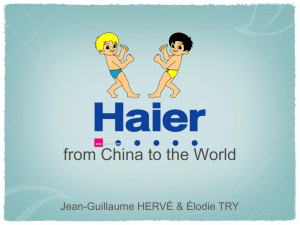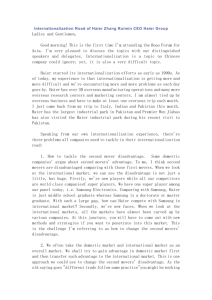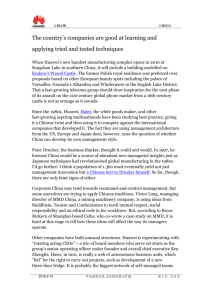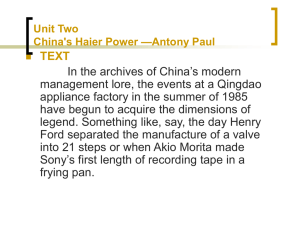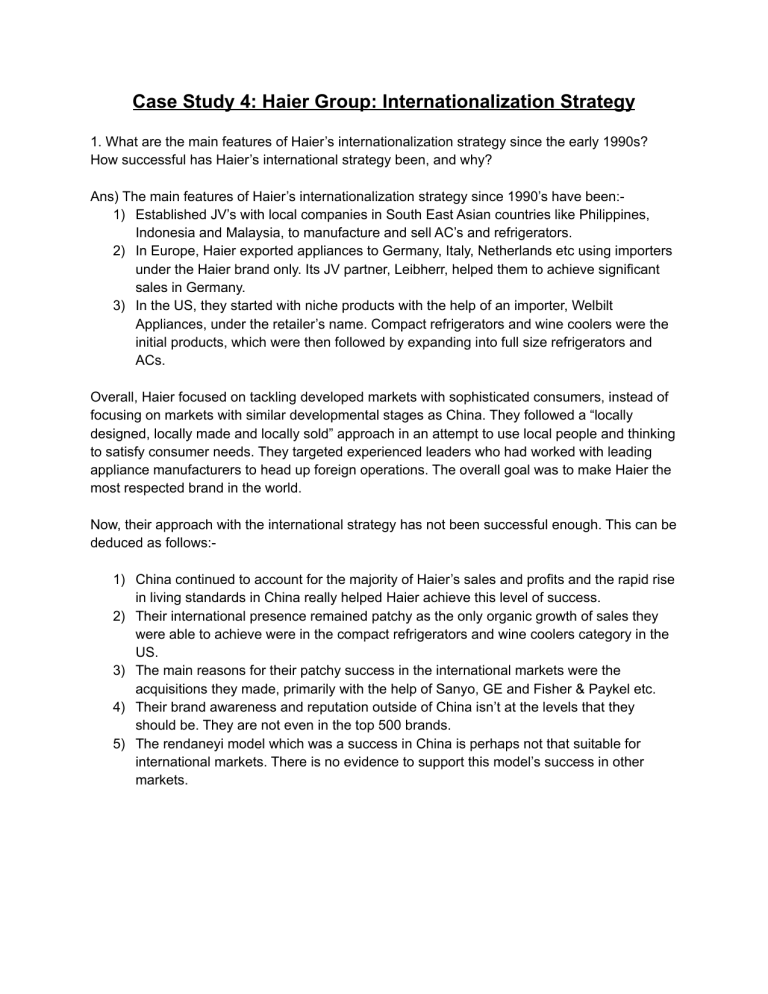
Case Study 4: Haier Group: Internationalization Strategy 1. What are the main features of Haier’s internationalization strategy since the early 1990s? How successful has Haier’s international strategy been, and why? Ans) The main features of Haier’s internationalization strategy since 1990’s have been:1) Established JV’s with local companies in South East Asian countries like Philippines, Indonesia and Malaysia, to manufacture and sell AC’s and refrigerators. 2) In Europe, Haier exported appliances to Germany, Italy, Netherlands etc using importers under the Haier brand only. Its JV partner, Leibherr, helped them to achieve significant sales in Germany. 3) In the US, they started with niche products with the help of an importer, Welbilt Appliances, under the retailer’s name. Compact refrigerators and wine coolers were the initial products, which were then followed by expanding into full size refrigerators and ACs. Overall, Haier focused on tackling developed markets with sophisticated consumers, instead of focusing on markets with similar developmental stages as China. They followed a “locally designed, locally made and locally sold” approach in an attempt to use local people and thinking to satisfy consumer needs. They targeted experienced leaders who had worked with leading appliance manufacturers to head up foreign operations. The overall goal was to make Haier the most respected brand in the world. Now, their approach with the international strategy has not been successful enough. This can be deduced as follows:1) China continued to account for the majority of Haier’s sales and profits and the rapid rise in living standards in China really helped Haier achieve this level of success. 2) Their international presence remained patchy as the only organic growth of sales they were able to achieve were in the compact refrigerators and wine coolers category in the US. 3) The main reasons for their patchy success in the international markets were the acquisitions they made, primarily with the help of Sanyo, GE and Fisher & Paykel etc. 4) Their brand awareness and reputation outside of China isn’t at the levels that they should be. They are not even in the top 500 brands. 5) The rendaneyi model which was a success in China is perhaps not that suitable for international markets. There is no evidence to support this model’s success in other markets. 2. What are the principal features of Haier’s management system? How does Haier’s internationalization strategy differ from the pattern of international development typical of Western enterprises? Ans) The principal features of Haier’s management system are:1) Governance in the form of ownership, organizational structure etc is unclear for Haier, as even the financial information is only available for two of its subsidiaries. Due to this opaque structure, Zhang Ruimin, has a lot of power concentrated with him for the decision making. His political contacts also help Haier maintain independence from municipal interference and help get valuable support from the Chinese central government. 2) The management of Zhang initially focused on brand building, new product development, quality management and customer focus. But the priorities gradually shifted towards rethinking the structure and management systems. All interactions had to be redefined around supplier-customer relationships. 3) They introduced OEC systems as part of a rigorous performance management based upon individual incentives and accountability. Monthly divisional targets were broken down into daily targets for all employees. Only if employees created value did they get paid. 4) They focused a lot on innovation and new product development. As a part of this, they adopted flexible modular designs and also were the industry leaders in providing internet connectivity for all these appliances. Some of their platforms also permitted users to permit large scale customizations. 5) More importantly, they ended up creating 2000+ self managed teams called ZZJYTs in a management model known as rendanheyi which transformed the enterprise from a closed to an open system. Employees ended up from being executors of top down directions to self motivated workers. Purchasers of products ended up being lifetime users. Leaders were assimilated to each local culture and were appointed using elections by the team and hence had powers similar to the CEO of a company and not divisional heads. Haier’s internationalization strategy differs from the pattern of international development by Western enterprises as they focused more on differentiation at a similar price point as compared to focusing on standardization of products amid economies of scale. Further, they aimed to use the rendanheyi model across all international divisions as well, which was different from other giants in the industry. Lastly, they also focused on a locally designed, locally made, locally sold approach which was different from other market leaders. 3. What recommendations would you make for Haier’s continuing success as a global leader in the appliance industry? Ans) For a continued success as a global leader in the appliance industry, I would suggest the following changes to Haier:1) Don’t be 100% focused on using the rendanheyi model across all markets. As you ensure that leaders are focused on local thinking and being assimilated to each culture, every culture has a different working style. Use data to find out which countries are not responding to this setup, and use a more traditional setup there. Some aspects of the company culture can still be kept, but don’t be very rigid about this approach. 2) Find out more niche products for each market using product development techniques. That is a strong point for Haier and only success in the US with compact refrigerators and wine coolers is a very minuscule success point. There will definitely be a lot more opportunities across markets which could be identified and made the most of. 3) Be more open about your financials and company data, especially for the entities not based in China. These could then be leveraged to provide confidence to customers who could then also become retail investors in the Haier stock in various stock markets and provide additional sources of income to the company. 4) Lastly, I would like to add that they should allow public scrutiny into their working, and allow 3rd party information to float out there. Only information from the company itself does not give customers confidence.
